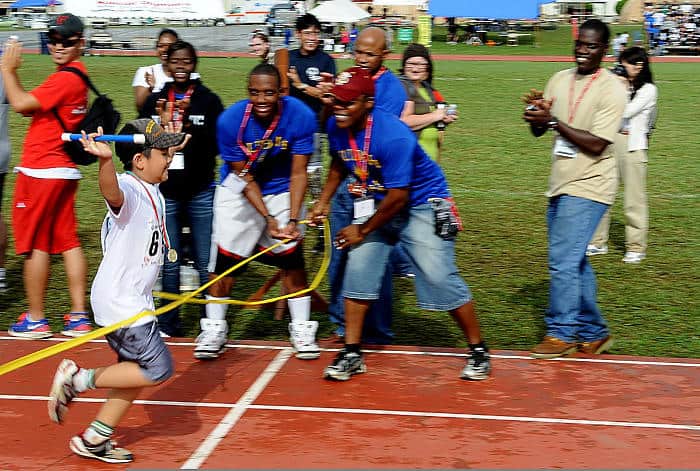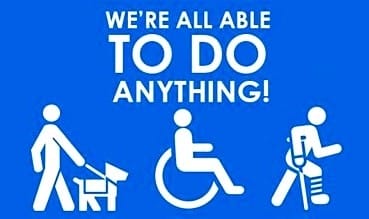
Nearly everyone knows someone who has a disability. Stevie Wonder once called on the world to open itself up to the disabled so that they can experience what the rest of us take for granted. I heard him call on Beyonce to have her songs released in Braille for the many blind musicians who would love to learn and play her music. From a purely business perspective it makes sense– disabled people spend money, too.
Children especially should be exposed to disability issues now because among them may be the few who one day make the discoveries that change the lives of disabled people everywhere.

Below are some books about autism and Downs Syndrome that might help bring additional exposure to the issues confronting the disabled. The books for children follow those for adults.
Be enlightened.
Recommended Reading For Adults
- Bernick, Michael S. and Richard Holden. The Autism Job Club: The Neurodiverse Workforce in the New Normal of Employment (Skyhorse Publishing, 2015). The authors review the high unemployment rates among adults with autism and other neuro- diverse conditions more than two decades after the ADA. National data on autism employment and unemployment with the individual employment searches of job club members.
- Brylla, Catalin and Helen Hughes. Documentary and Disability (Palgrave Macmillan, 2017). This edited collection of contributions from media scholars, film practitioners and film historians connects the vibrant fields of documentary and disability studies.
- Burns, David D. Feeling Good: The New Mood Therapy (Harper, 2008). In Feeling Good, eminent psychiatrist, David D. Burns, M.D., outlines the remarkable, scientifically proven techniques that will immediately lift your spirits and help you develop a positive outlook on life.
- Burns, David D. Ten Days to Self-Esteem (William Morrow Paperbacks, 1999). In Ten Days to Self-esteem, Dr. David Burns presents innovative, clear, and compassionate methods that will help you identify the causes of your mood slumps and develop a more positive outlook on life.
- Christensen, Shelly. From Longing to Belonging: A Practical Guide to Including People with Disabilities and Mental Health Conditions in Your Faith Community (Inclusion Innovations, 2018). From Longing to Belonging is a comprehensive approach to inclusion of people with disabilities and mental health conditions written by one of the leading voices in the faith community disability inclusion movement.
- Davis, Lennard J. Enabling Acts: The Hidden Story of How the Americans with Disabilities Act Gave the Largest US Minority Its Rights (Beacon Press, 2015). A gripping and nuanced telling of the behind-the-scenes efforts to pass the Americans with Disabilities Act.
- Donovan, Rich. Unleash Different: Achieving Business Success Through Disability (ECW Press, 2018). Unleash Different illustrates how companies like Google, PepsiCo, and Nordstrom are attracting people with disabilities as customers and as employees.
- Guidotti, Rick. Change How You See, See How You Change (Positive Exposure Productions Inc, 2016). This illustrious and uplifting book explores the near twenty-year journey of Positive Exposure’s founder and award-winning photographer, Rick Guidotti, on his quest to discover the beauty in genetic diversity.
- Kennedy, Dan. Little People: Learning to See the World Through My Daughter’s Eyes (Rodale Books, 2003). In Little People, Dan Kennedy profiles individuals whose small stature has helped them to succeed, and others who have allowed themselves to be exploited and abused.
- Prizant, Barry M. Uniquely Human: A Different Way of Seeing Autism (Simon & Schuster, 2016). Autism therapy typically focuses on ridding individuals of “autistic” symptoms such as difficulties interacting socially, problems in communicating, sensory challenges, and repetitive behavior patterns. Now Dr. Barry M. Prizant offers a new and compelling paradigm: the most successful approaches to autism don’t aim at fixing a person by eliminating symptoms, but rather seeking to understand the individual’s experience and what underlies the behavior.
- Ruh, Debra. Inclusion Branding: Revealing Secrets to Maximize ROI (Ruh Global, LLC, 2018). Revealing step-by-step, chapter-by-chapter strategies brands can implement to effectively include Persons with Disabilities (PWD) into their customer and employee base, tapping into the trillions available through PWD market, Debra Ruh delivers insights and methodologies used in her 30+ years advising and assisting The United Nations, countries, and multi-national corporations.
- Shapiro, Joseph P. No Pity: People with Disabilities Forging a New Civil Rights Movement (Broadway Books, 1994). An historical, in-depth look at people with disabilities. The book also takes a close look at the advocacy efforts that led to the passage of the Americans with Disabilities Act.
- Solomon, Andrew. Far From the Tree: Parents, Children and the Search for Identity (Scribner, 2012). A deeply touching look at how parents and children can learn to accept and embrace differences. The people featured in this book demonstrate how lives with extreme challenges also have extreme value.
Recommended Reading for Children
- Glatzer, Jenna. Taking Down Syndrome to School (Special Kids in School) (JayJo Books, 2002). Picture book about what it is like to have Down syndrome in school. Appropriate for children in elementary school.
- Ling, Nancy Tupper. My Sister, Alicia May (Pleasant St. Press, 2009). What it’s like to grow up with a sister with Down syndrome. Appropriate for children in first to third grade.
- Llano, Gabriella and Tiziana Vazquez. In My World: Down Syndrome (AuthorHouse, 2013). With the support of her family, a girl with Down syndrome lives her life and learns to accept being herself. Appropriate for children in elementary school.
- Palacio, R.J. Wonder (Knopf Books for Young Readers, 2012). A story about a boy born with facial defects. Appropriate for children ages 8 to 12.
- Paticoff, Melanie. Sophie’s Tales: Overcoming Obstacles (Sophie’s Tales, 2012). A dog with a cochlear implant meets Champ, another dog who wears glasses, and they talk about disability. Appropriate for children ages 3 to 10.
- Robinson Peete, Holly and Ryan Elizabeth Peete. My Brother Charlie (Scholastic Press, 2010). Story told from the point of view of the twin sister of a boy on the autism spectrum. Appropriate for children in kindergarten to second grade.
- Stuve-Bodeen, Stephanie. We’ll Paint the Octopus Red (Woodbine House, 1998). A six-year-old girl learns how to be a good big sister to a baby brother with Down syndrome. Appropriate for children in kindergarten to third grade.
- Woloson, Eliza. My Friend Isabelle (Woodbine House, 2003). Story of a friendship when one of the friends has Down syndrome. Appropriate for children in kindergarten to second grade.

